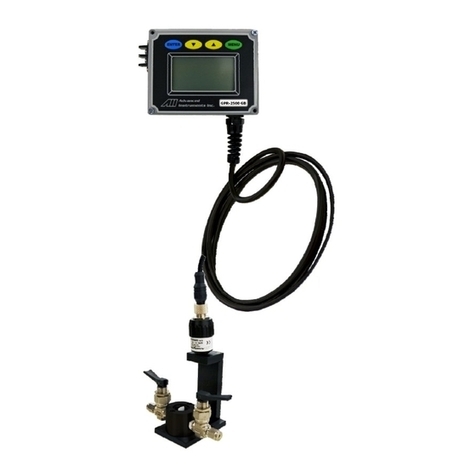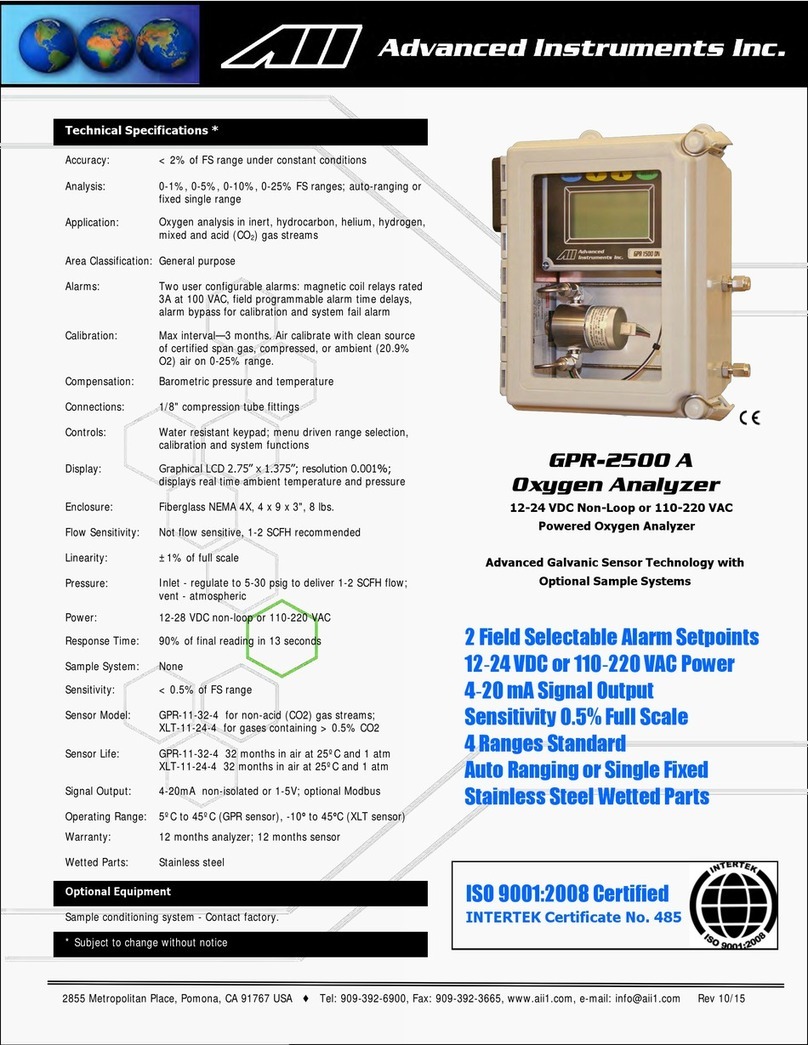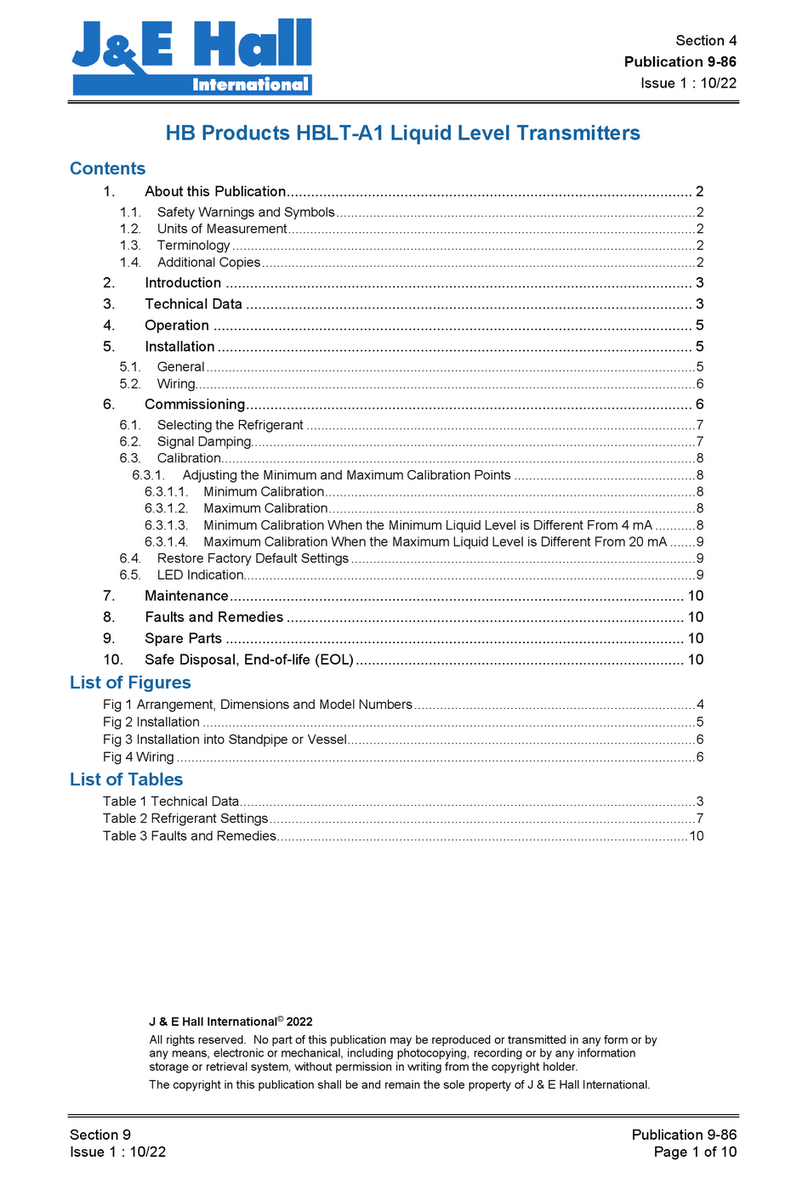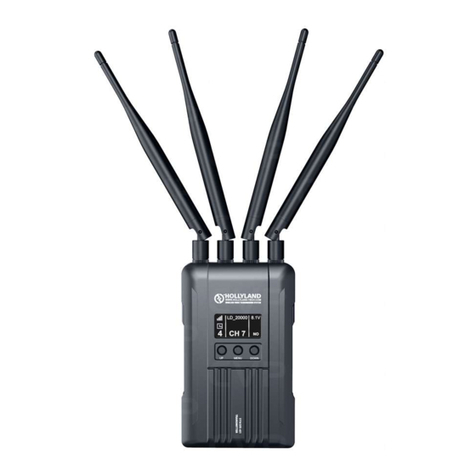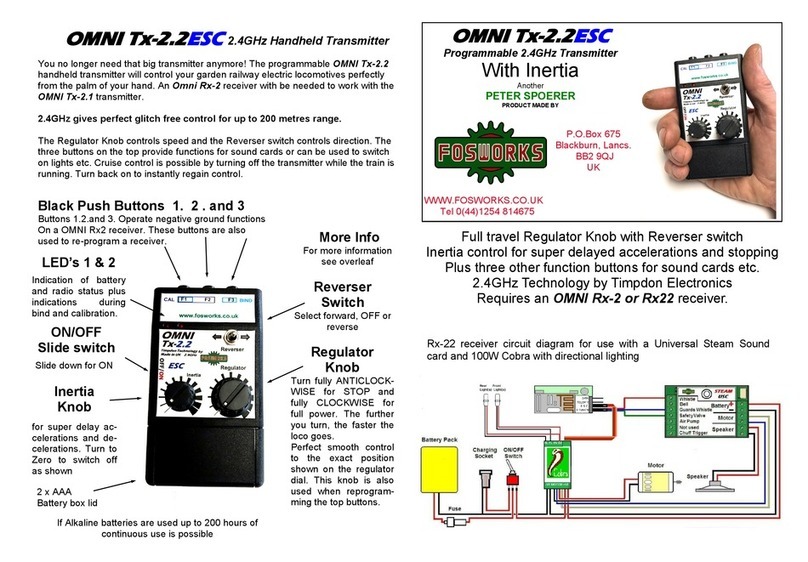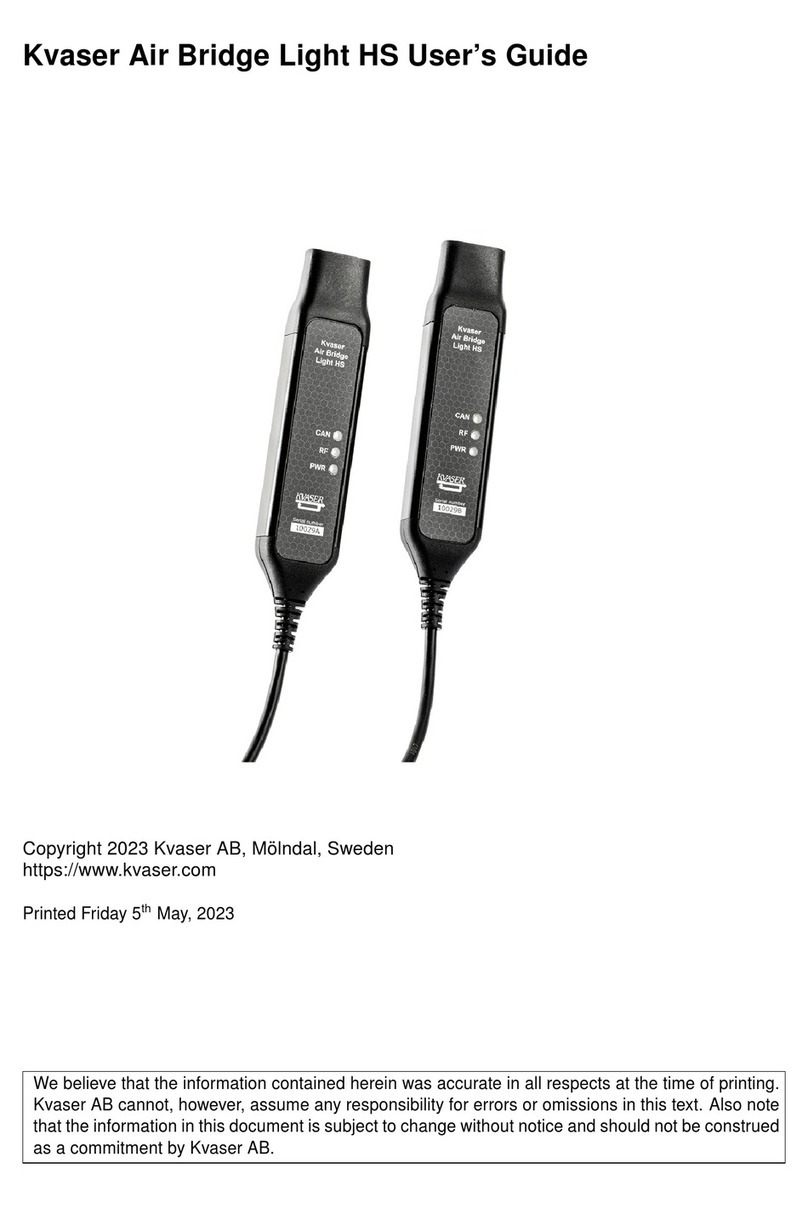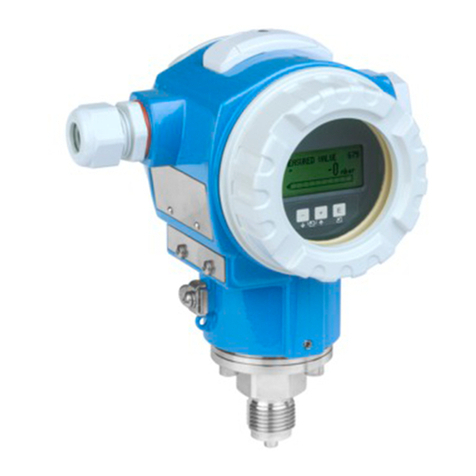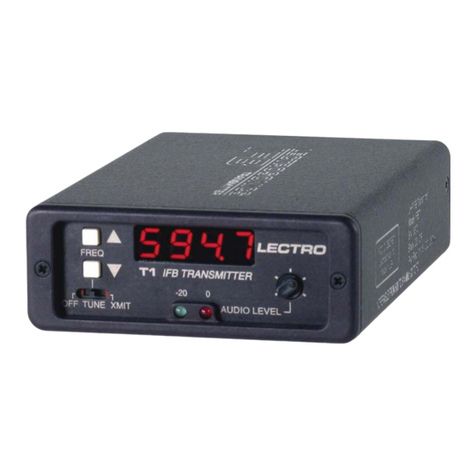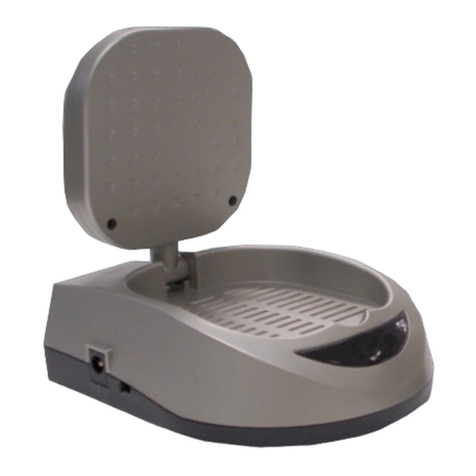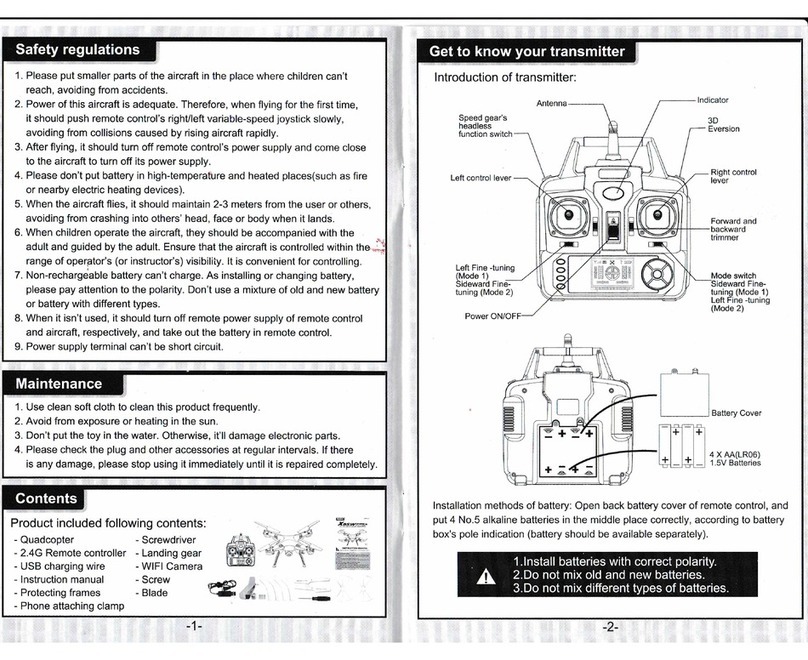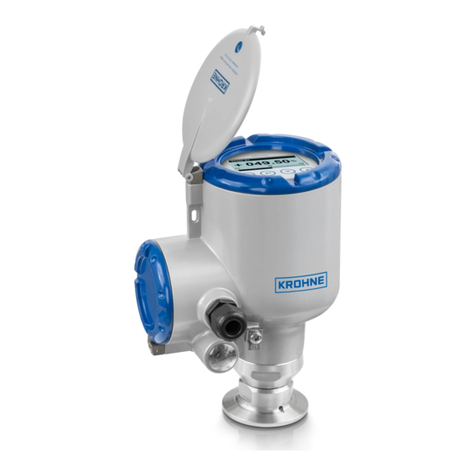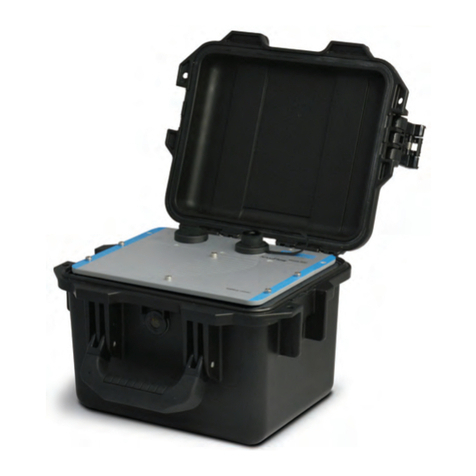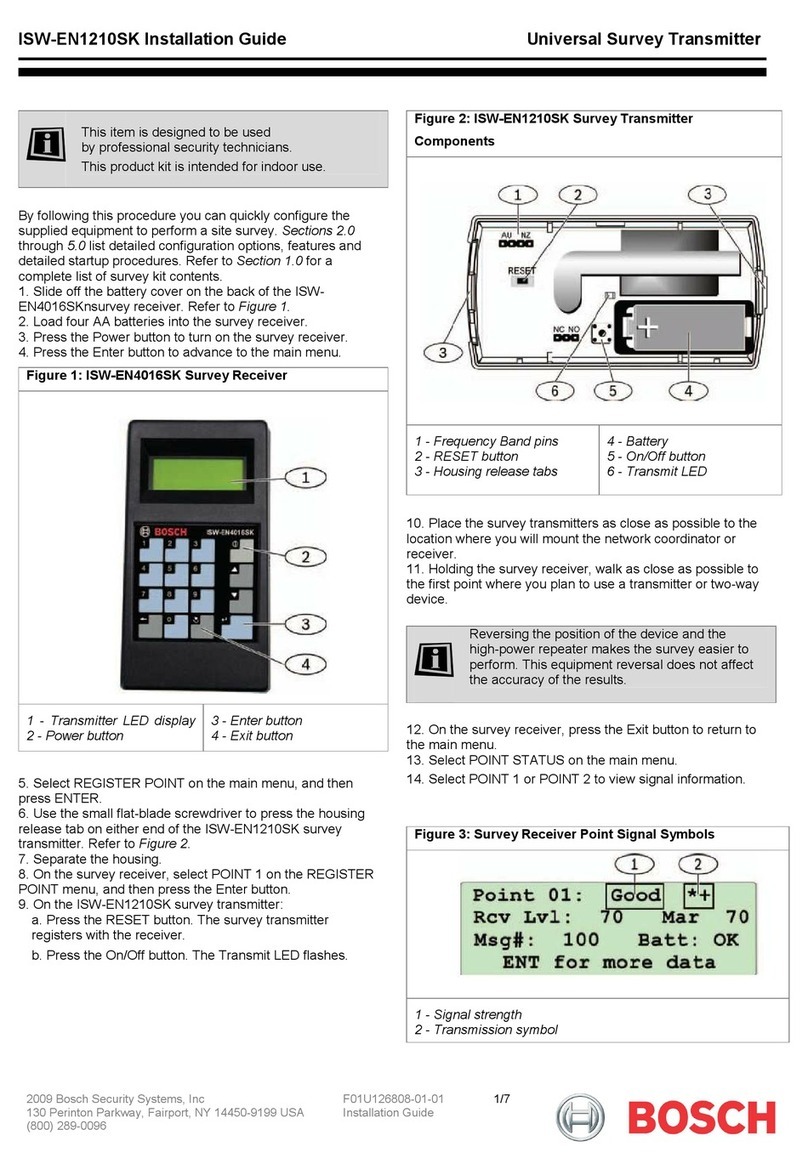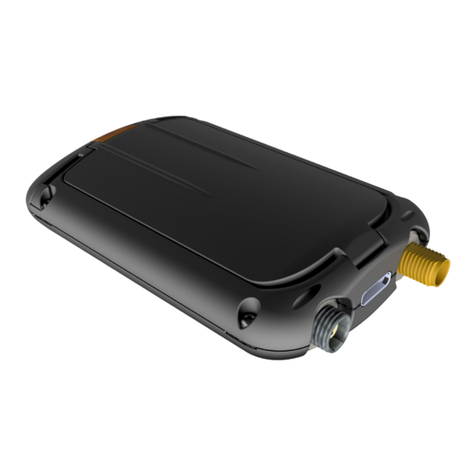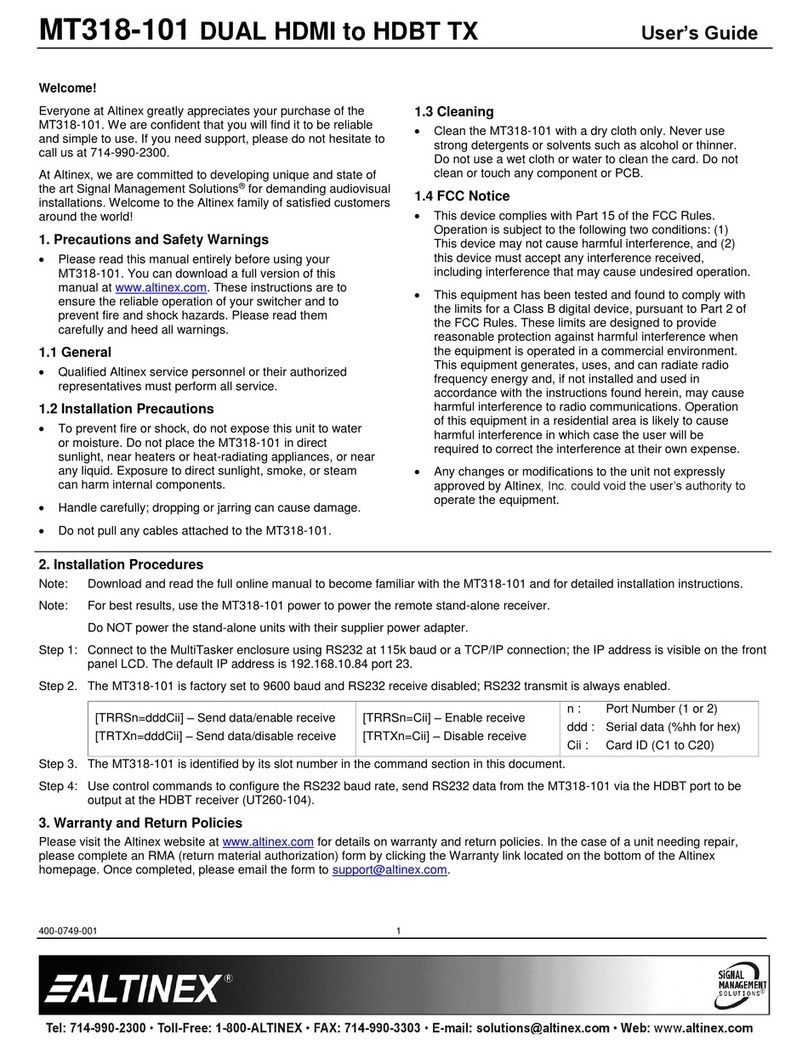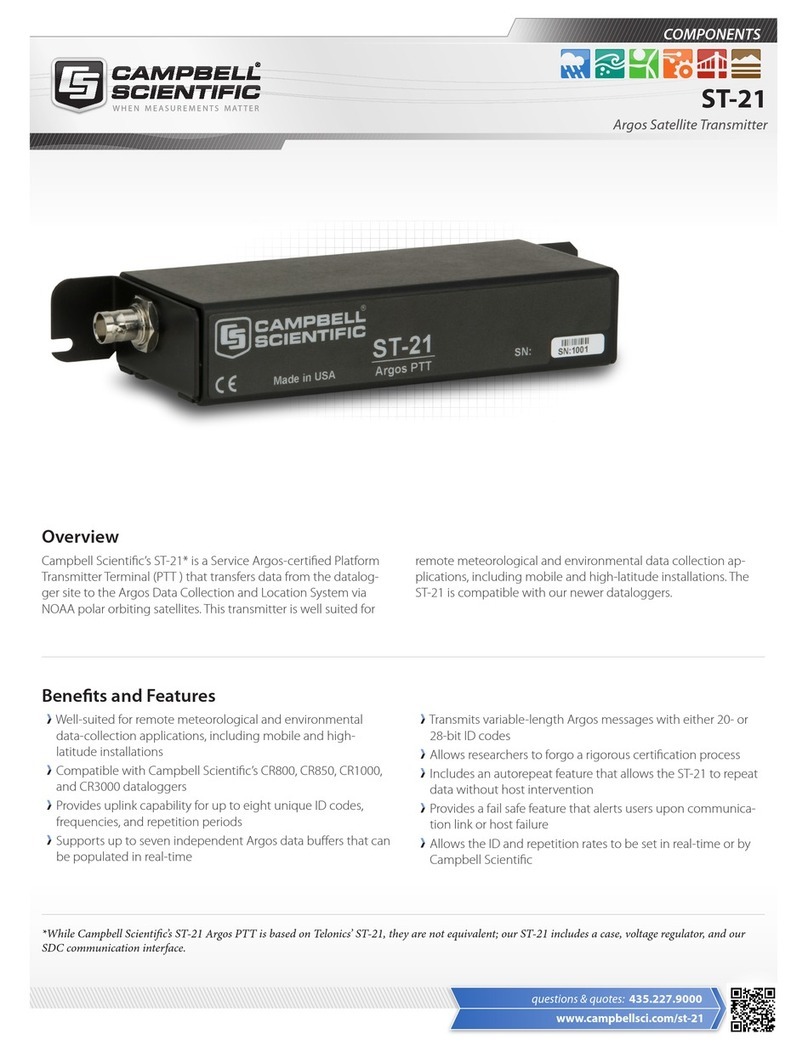Advanced Instruments GPR-2800 IS User manual

2855 Metropolitan Place, Pomona, CA 91767 USA ♦Tel: 909-392-6900, Fax: 909-392-3665, www.aii1.com, e-mail: [email protected] Rev 10/15
ISO 9001:2008 Certified
INTERTEK Certificate No. 485
GPR-2800 IS
Oxygen Transmitter
Loop Powered O2 Transmitter
Optional Modular Sample Systems
Technical Specifications *
Accuracy: < 2% of FS range under constant conditions
Analysis: 0-1%, 0-5%, 0-10%, 0-25% FS ranges; auto-ranging
or fixed single range
Application: Oxygen analysis in inert, hydrocarbon, helium, hydro-
gen, mixed and acid (CO2) gas streams
Approvals: Certified for use in hazardous areas - see lower right
UL: United States: UL 1203, UL 913, UL 508
Canada: CAN/CSA C22.2 No. 30-M1986,
CAN/CSA C22.2 No. 157-92,
CAN/CSA C22.2 No. 14-10
ATEX: Directive 94/9/EC
Area Classification: Certified for use in hazardous areas - see lower right
Calibration: Max interval—3 months. Air calibrate with clean
source of certified span gas, compressed, or ambient
(20.9% O2) air on 0-25% range.
Compensation: Temperature
Connections: 1/8" compression tube fittings
Controls: Water resistant keypad; menu driven range selection,
calibration and system functions
Display: Graphical LCD 2.75” x 1.375”; resolution 0.001%;
displays real time ambient temperature and pressure
Enclosure: NEMA Type 3R for rain in outdoor applications (UL)
NEMA 4X (ATEX)
Flow: Not flow sensitive; recommended flow rate 1-2 SCFH
Linearity: ±1% of full scale
Pressure: Inlet - regulate to 5-30 psig to deliver 1-2 SCFH flow;
vent - atmospheric
Power: 18-24 VDC
Response Time: 90% of final reading in 10 seconds
Sample System: Sample flow meter; options available, see other side
Sensitivity: < 0.5% of FS range
Sensor Model: GPR-11-32 for non-acid (CO2) gas streams
XLT-11-24 for gases containing > 0.5% CO2
Sensor Life: GPR-11-32 32 months in air at 25°C and 1 atm
XLT-11-24 24 months in air at 25°C and 1 atm
Signal Output: 4-20mA
Operating Range: 5ºC to 45ºC (GPR sensor); -10ºto 45ºC (XLT)
Warranty: 12 months analyzer; 12 months sensor
Wetted Parts: Stainless steel
Optional Equipment
Sample conditioning systems (see back page) - Contact factory
* Specifications subject to change without notice
Exia
UL Certified
File E343386
Class I, Division 1, Groups C and D
T4 Tamb -20⁰C to +50⁰C
0080
ATEX Certified - Directive 94/9/EC
Examination Cert: INERIS 08ATEX0036
II 2 G
Ex d [ib] ib IIB T4
Tamb -20⁰C to +50⁰C
UL or ATEX Certified for Hazardous Areas

Advanced Instruments Inc.
2855 Metropolitan Place, Pomona, California 91767 USA ♦Tel: 909-392-6900, Fax: 909-392-3665, e-
GPR-2800 IS
PPM Oxygen Transmitter
Shown with Optional A-3393-6 Sample System
Owner’sManual

Advanced Instruments, Inc
2
TableofContents
Introduction 1
Quality Control Certification 2
Safety 3
Features & Specifications 4
Operation 5
Maintenance 6
Spare Parts 7
Troubleshooting 8
Warranty 9
Material Safety Data Sheets 10
Drawings A/R
Explosion Proofing Electrical Connections Appendix A
Correlating readings – LCD display to 4-20mA signal
output Appendix B
H2S Scrubber, Sample System, Media MSDS Appendix F
Maintenance H2S Scrubber & Coalescing Filter Appendix G
The appendices referenced above are an integral part of the documentation, installation and maintenance of
this analyzer to comply with all applicable directives. It is important that users review these documents
before proceeding.

Advanced Instruments, Inc
3
1. Introduction
Your new oxygen transmitter incorporates an advanced electrochemical sensor specific to oxygen along
with state-of-the-art digital electronics designed to give you years of reliable precise oxygen measurements
in a variety of industrial oxygen applications. More importantly, it has been constructed as intrinsically safe in
accordance with ATEX Directives 94/9/EC for use in hazardous areas in zone 1 Group C and D.
T
h
e
d
e
s
i
g
n
a
l
s
o
m
e
e
t
s
The transmitter also complies with NEC intrinsic safety standards for use in Class 1, Division 1, Group C, D
hazardous areas. Please refer to Appendix A for information on making electrical connections that maintain
the desired level of protection.
To obtain maximum performance from your new oxygen transmitter, please read and follow the guidelines
provided in this Owner’s Manual.
Every effort has been made to select the most reliable state of the art materials and components, to design
the transmitter for superior performance and minimal cost of ownership. This transmitter was tested
thoroughly by the manufacturer prior to shipment for best performance.
However, modern electronic devices do require service from time to time. The warranty included herein plus
a staff of trained professional technicians to quickly service your transmitter is your assurance that we stand
behind every transmitter sold.
The serial number of this transmitter may be found on the inside the transmitter enclosure. You should note
the serial number in the space provided and retains this Owner’s Manual as a permanent record of your
purchase, for future reference and for warranty considerations.
Serial Number: _______________________
Advanced Instruments Inc. appreciates your business and pledges to make every effort to maintain the
highest possible quality standards with respect to product design, manufacturing and service.
Analytical Industries Inc.
dba Advanced Instruments Inc.
2855 Metropolitan Place, Pomona, CA 91767 USA
GPR-1800IS/2800IS
0080
Serial No.:
Year of Manufacture:
INERIS 08ATEX0036
II 2 G
Ex d [ib] ib IIB T4
Tamb -20⁰C to +50⁰C
WARNING: POTENTIAL ELECTROSTATIC CHARGING HAZARD – SEE
INSTRUCTIONS

Advanced Instruments, Inc
4
3.GeneralSafety&Installation
This section summarizes the essential precautions applicable to the GPR-2800IS Oxygen Transmitter.
Additional precautions specific to individual transmitter are contained in the following sections of this manual.
To operate the transmitter safely and obtain maximum performance follow the basic guidelines outlined in
this Owner’s Manual.
Caution: This symbol is used throughout the Owner’s Manual to Caution and alert the user to
recommended safety and/or operating guidelines.
Warning: This symbol is used throughout the Owner’s Manual to Warn and alert the user of the
presence of electrostatic discharge.
Danger: This symbol is used throughout the Owner’s Manual to identify sources of immediate
Danger such as the presence of hazardous voltages.
Read Instructions: Before operating the transmitter read the instructions.
Retain Instructions: The safety precautions and operating instructions found in the Owner’s Manual should
be retained for future reference.
Heed Warnings: Follow all warnings on the transmitter, accessories (if any) and in this Owner’s Manual.
Follow Instructions: Observe all precautions and operating instructions. Failure to do so may result in
personal injury or damage to the transmitter.
Analyzer label

Advanced Instruments, Inc
5
2. Quality Control Certification

Advanced Instruments, Inc
6
Maintenance
Serviceability: Except for replacing the oxygen sensor, there are no parts inside the transmitter for the
operator to service.
Only trained personnel with the authorization of their supervisor should conduct maintenance.
Oxygen Sensor: DO NOT open the sensor. The sensor contains a corrosive liquid electrolyte that could be
harmful if touched or ingested, refer to the Material Safety Data Sheet contained in the Owner’s Manual
appendix. Avoid contact with any liquid or crystal type powder in or around the sensor or sensor housing, as
either could be a form of electrolyte. Leaking sensors should be disposed of in accordance with local
regulations.
Troubleshooting: Consult the guidelines in Section 8 for advice on the common operating errors before
concluding that your transmitter is faulty. Do not attempt to service the transmitter beyond those means
described in this Owner’s Manual.
Do not attempt to make repairs by yourself as this will void the warranty as per Section 10 and may result in
electrical shock, injury or damage. All other servicing should be referred to qualified service personnel.
Cleaning: The transmitter should be cleaned only as recommended by the manufacturer. Wipe off dust and
dirt from the outside of the unit with a soft damp cloth then dry immediately. Do not use solvents or
chemicals.
Nonuse Periods: If the transmitter is equipped with a range switch advance the switch to the OFF position
and disconnect the power when the transmitter is left unused for a long period of time.
Installation
This analyzer has been constructed in compliance with
EN 60079-0 : 2006
EN 60079-1 : 2004
EN 60079-11 : 2007
It must be installed in accordance with
EN 60079-14
Gas Sample Stream: Ensure the gas stream composition of the application is consistent with the
specifications and if in doubt, review the application and consult the factory before initiating the installation.
Note: In natural gas applications such as extraction and transmission, a low voltage current is applied to the
pipeline itself to inhibit corrosion of the pipeline. As a result, electronic devices connected to the pipeline can
be affected unless they are adequately grounded.
Contaminant Gases: A gas scrubber and flow indicator with integral metering valve are required upstream
of the of the analyzer to remove any interfering gases such as oxides of sulfur and nitrogen or hydrogen
sulfide that can interfere with measurement and cause reduction in the expected life of the sensor. Consult
the factory for recommendations concerning the proper selection and installation of components.

Advanced Instruments, Inc
7
Expected Sensor Life: With reference to the publish specification located at the last page of this manual,
the expected life of all oxygen sensors is predicated on oxygen concentration (< 1000 ppm for PPM sensor
or air for % sensor), temperature (77°F/25°C) and pressure (1 atmosphere) in “normal” applications.
Deviations from standard conditions will affect the life of the sensor. As a rule of thumb sensor life is
inversely proportional to changes in the pressure and temperature..
Accuracy & Calibration: Refer to section 5 Operation.
Materials: Assemble the necessary zero, sample and span gases and optional components such as valves,
coalescing or particulate filters, and pumps as dictated by the application. Stainless steel tubing is essential
for maintaining the integrity of the gas stream for low % or PPM O2level analysis.
Operating Temperature: The sample must be sufficiently cooled before it enters the analyzer and any
optional components. A coiled 10 foot length of ¼” stainless steel tubing is sufficient for cooling sample
gases as high as 1,800 ºF to ambient. The recommended operating temperature is below 35 ºC. However,
the analyzer may be operated at temperature up to 45 ºC on an intermittent basis but the user is expected to
accept a reduction in expected sensor life –as a rule of thumb, for every degree ºC increase in temperature
(above 25 ºC), the sensor life is reduced by approximately 2.5%.
Heat: Situate and store the analyzer away from direct sources of heat.
Liquid and Object Entry: The analyzer should not be immersed in any liquid. Care should be taken so that
liquids are not spilled into and objects do not fall into the inside of the analyzer.
Handling: Do not use force when using the switches, knobs or other mechanical components. Before
moving your analyzer be sure to disconnect the wiring/power cord and any cables connected to the output
terminals of the analyzer.
SamplePressureandFlow
All electrochemical oxygen sensors respond to partial pressure changes in oxygen. The sensors are equally
capable of analyzing the oxygen content of a flowing sample gas stream or monitoring the oxygen
concentration in ambient air (such as a confined space in a control room or an open area around a landfill or
bio-pond). The following is applicable to analyzers equipped with fuel cell type oxygen sensors.
Analyzers designed for in-situ ambient or area monitoring has no real sample inlet and vent. The sensor is
exposed directly to the sample gas and it is intended to operate at atmospheric pressure. The analyzer has
a built-in pressure sensor and the sensor output is automatically compensated for any atmospheric pressure
changes.
Inlet Pressure: For the analyzers designed to measure oxygen in a flowing gas stream, the inlet
sample pressure must be regulated between 5-30 psig. Although the rating of the SS tubing and tube
fittings/valves itself is considerably higher (more than 100 psig), a sample pressure of 5-30 psig is
recommended for ease of control of sample flow.
The analyzer equipped with a sample system has designated SAMPLE and VENT ports. Connect SAMPLE
gas to SAMPLE and the vent to the VENT ports only.
Caution: If the analyzer is equipped with an optional H2S scrubber, sample inlet pressure must not
exceed 30 psig.

Advanced Instruments, Inc
8
Outlet Pressure:In applications where sample pressure is positive, the sample must be vented to an
exhaust pipe at a pressure less than the inlet pressure so that the sample gas can flow through the sensor
housing. Ideally, the sample must be vented to atmospheric pressure. .
Note: The sensor may be used at a slight positive pressure (e.g., when sample is vented to a common
exhaust where the pressure might be higher than 1 atmosphere). However, the pressure at the sensor must
be maintained at all times including during the span calibration. This may be accomplished by using a back-
pressure regulator at vent line of the analyzer. Caution: A sudden change in pressure at the sensor may
result in the sensor electrolyte leakage.
Flow rates of 1-5 SCFH cause no appreciable change in the oxygen reading. However, flow rates above 5
SCFH may generate a slight backpressure on the sensor resulting in erroneous oxygen readings.
Caution: Do not place your finger over the vent (it pressurizes the sensor) to test the flow indicator
when gas is flowing to the sensor. Removing your finger (the restriction) generates a vacuum on
the sensor and may damage the sensor (voiding the sensor warranty).
Application Pressure - Positive:A flow indicator with integral metering valve positioned
upstream of the sensor is recommended for controlling the sample flow rate between 1-5 SCFH. If a
separate flow control valve and a flow indicator is used, position flow control valve upstream of the sensor
and position a flow indicator downstream of the sensor. If necessary, a pressure regulator upstream of the
flow control valve should be used to regulate the inlet pressure between 5-30 psig.
Caution: If the analyzer is equipped with a H2S scrubber as part of an optional sample conditioning
system, inlet pressure must not exceed 30 psig.
Application Pressure - Atmospheric or Slightly Negative: For % oxygen
measurements, an optional external sample pump may be used upstream of the sensor to push the sample
across the sensor and out to atmosphere. For PPM oxygen measurements, an optional external sampling
pump should be positioned downstream of the sensor to draw the sample from the process, by the sensor
and out to atmosphere. A flow meter is generally not necessary to obtain the recommended flow rate with
most sampling pumps. However, if the sample pump can pull/push more than 5 SCFH, a flow control must
be used to control the sample flow. The flow control valve must be positioned in such a way that it does not
generate any vacuum on the sensor.
Caution: If the analyzer is equipped with a flow indicator with integral metering valve or a metering
flow control valve upstream of the sensor and the pump is installed downstream of sensor- open
the metering valve completely before turning the pump ON to avoid drawing a vacuum on the
sensor and placing an undue burden on the pump.
If pump loading is a consideration, a second throttle valve on the pump’s inlet side may be necessary to
provide a bypass path so the sample flow rate is within the above parameters.
Moisture & Particulates: Installation of a suitable coalescing or particulate filter is required to
remove condensation, moisture and/or particulates from the sample gas to prevent erroneous analysis
readings and damage to the sensor or other optional components. Moisture and/or particulates do not
necessarily damage the sensor. However, collection of moisture/particulate on the sensing surface can
block or inhibit the diffusion of sample gas into the sensor resulting in a reduction of sensor signal output –
and the appearance of a sensor failure. Consult the factory for recommendations concerning the proper
selection and installation of optional components.
Moisture and/or particulates generally can be removed from the sensor by opening the sensor housing and
either blowing on the sensing surface or gently wiping or brushing the sensing surface with damp cloth.
Caution: Minimize the exposure of PPM sensors to air during this cleaning process. Air calibration followed

Advanced Instruments, Inc
9
by purging with zero or a gas with a low PPM oxygen concentration is recommended after the cleaning
process is completed.
Mounting: The analyzer is approved for indoor as well as outdoor use. However, avoid mounting in an
area where direct sun might heat up the analyzer beyond the recommended operating temperature range. If
possible, install a small hood over the analyzer for rain water drain and to prevent over-heating of analyzer..
Gas Connections: The Inlet and outlet vent gas lines require 1/8” or ¼” stainless steel compression
type tube fittings. The sample inlet tubing must be metallic, preferably SS. The sample vent line may be of
SS or hard plastic tubing with low gas permeability.
Power: Supply power to the analyzer only as rated by the specification or markings on the analyzer
enclosure. The GPR-2800 IS/1800 IS is a two wire loop powered analyzer. The input power must be
between 12-24 VDC. The wiring that connects the analyzer to the power source should be installed in
accordance with recognized electrical standards. Ensure that the analyzer case is properly grounded and
meets the requirements for area classification where the analyzer is installed. Never yank wiring to remove it
from a terminal connection.
The two wire loop powered analyzers consume no more than 0.68 Watts of power.

Advanced Instruments, Inc
10
4.Features & Specifications

Advanced Instruments, Inc
11
5.Operation
PrincipleofOperation
The GPR-2800 IS/1800 IS Oxygen Transmitter incorporates a variety of advanced galvanic fuel cell type
oxygen sensors. These sensors are very specific to oxygen and generate an electrical signal proportional to
the amount of oxygen present in a gas stream. The selection of particular type of sensor depends on the
composition of the sample gas stream. Consult the factory for recommendation.
The transmitter is configured in two sections. The signal processing electronics and sensor are housed in a
general purpose NEMA 4X rated enclosure. The terminals for incoming power, signal output and intrinsic
safety barriers are mounted on a PCB housed in an explosion proof enclosure.
The two sets of electronics are interconnected using an explosion proof Y-fitting, explosion proof packing
fiber and sealing cement – see Appendix A. Once connected, the intrinsic safety barriers limit the amount of
power that flows to and from the signal processing electronics effectively preventing an explosive condition.
The analyzer design conforms to the ATEX directive for equipment as intrinsically safe and has been
approved by an independent body:
The analyzer carries the following area classification
II 2 G
Ex d [ib] ib IIB T4
Tamb -20⁰C to +50⁰C
The GPR-2800 IS/1800 IS also meets the intrinsic safety standards required for use in Class 1, Division 1,
Group C, D hazardous areas.

Advanced Instruments, Inc
12
AdvancedGalvanicSensorTechnology
All galvanic type sensors function on the same principle and are specific to oxygen. They measure the
partial pressure of oxygen from low PPM to 100% levels in inert gases, gaseous hydrocarbons, helium,
hydrogen and mixed gases
Oxygen, the fuel for this electrochemical transducer, diffusing into the sensor, reacts electrochemically at the
sensing electrode to produce an electrical current output proportional to the oxygen concentration in the gas
phase. The sensor’s signal output is linear over all measuring ranges and remains virtually constant over its
useful life. The sensor requires no maintenance and is easily and safely replaced at the end of its useful life.
Proprietary advancements in design and chemistry add significant advantages to this extremely versatile
oxygen sensing technology. Sensors for low % analysis recover from air to low % levels in seconds, exhibit
longer life and reliable quality. The expected life of our new generation of percentage range sensors now
range from 32 months to ten years with faster response times and greater stability. Another significant
development involves expanding the operating temperature range for percentage range sensors from -30°C
to 50°C. Contact factory for more specific information about your application.
The PPM sensors recover from an upset condition to low PPM level in a matter of few minutes. These
sensors show excellent stability over its useful life.
Electronics
The signal generated by the sensor is processed by state of the art low power micro-processor based digital
circuitry. The first stage amplifies the signal. The second stage eliminates the low frequency noise. The third
stage employs a high frequency filter and compensates for signal output variations caused by ambient
temperature changes. The result is a very stable signal. Sample oxygen is analyzed very accurately.
Response time of 90% of full scale is less than 10 seconds (actual experience may vary due to the integrity
of sample line connections, dead volume and flow rate selected) on all ranges under ambient monitoring
conditions. Sensitivity is typically 0.5% of full scale of the low range. Oxygen readings may be recorded by
an external device via the 4-20 mA or 1-5V signal output.

Advanced Instruments, Inc
13
SampleSystem
The standard GPR-2800 IS is supplied without a sample conditioning system thereby giving users the option
of adding their own or purchasing a factory designed sample conditioning system, see section 2 QC
Certification for optional equipment ordered. Whatever the choice, the sample must be properly conditioned
before introducing it to the sensor to ensure an accurate measurement.
The GPR-2800 IS is generally supplied with a minimum of a sample flow control valve and a flow meter.
Users interested in adding their own sample conditioning system should consult the factory. Advanced
Instruments Inc. offers a full range of sample handling, conditioning and expertise to meet your application
Calibration&AccuracyOverview
Single Point Calibration: As previously
described the galvanic type oxygen sensor
generates an electrical current proportional to
the oxygen concentration in the sample gas. In
the absence of oxygen the sensor exhibits an
absolute zero, e.g. the sensor does not
generate a current output in the absence of
oxygen. Given these linearity and absolute zero
properties, single point calibration is possible.
Pressure: Because sensors are sensitive to
the partial pressure of oxygen in the sample
gas, their output is a function of the number of
molecules of oxygen 'per unit volume'.
Readouts in percent are permissible only when
the total pressure of the sample gas being
analyzed remains constant. The pressure of the sample gas and that of the calibration gas must be the
same.
Temperature: The rate at which oxygen molecules diffuse into the sensor is controlled by a Teflon
membrane otherwise known as an 'oxygen diffusion limiting barrier' and all diffusion processes are
temperature sensitive, the fact the sensor's electrical output will vary with temperature is normal. This
variation is relatively constant (2.5% per ºC). A temperature compensation circuit employing a thermistor and
a network of resisters offsets this effect with an accuracy of +5% or better over a wide operating temperature
range e.g., 5-45 oC can be obtained thus the signal output remains virtually independent of ambient
temperature. There is extremely low error in measurement if the calibration and sampling are performed at
similar temperatures (within +/- 5 ºC. Conversely, a temperature variation of 10 ºC may produce an error of <
2% of full scale.
Accuracy: In light of the above parameters, the overall accuracy of an analyzer is affected by two types of
errors: 1) 'percent of reading errors', illustrated by Graph A below, is contributed by the temperature
compensation circuit (tolerance in the thermistor value, variation in temperature coefficient of the thermistor,
tolerances in resistors values and the accuracy in the measuring devices, e.g., LCD display and 2) 'percent
of full scale errors', illustrated by Graph B, such as1-2% offset errors in readout and calibration devices.
Other errors are 'spanned out' during calibration, especially when analyzer is calibrated close to the top end
of the measuring range.
Graph C illustrates these 'worse case' specifications that are typically used to develop an overall accuracy
statement of < 1% of full scale at constant temperature or < 5% over the operating temperature range. The
QC testing error is typically < 0.5% prior to shipment of analyzer from the factory.

Advanced Instruments, Inc
14
Example 1: As illustrated by Graph A, any error during a span adjustment at lower end of the scale, e.g.,
20.9% (air) on a 100% full scale range, would be multiplied by a factor of 4.78 (100/20.9) when making
measurements close to 100% O2. Conversely, an error during a span adjustment close to the top end of the
range, e.g., at 100% is reduced proportionately for measurements of oxygen concentrations near the bottom
end of the range.
Graph B represents a constant error over the entire measuring range. This error is generally associated with
the measuring e.g., LCD and or calibrating devices, e.g., current simulator or current/voltage measuring
devices.

Advanced Instruments, Inc
15
MountingtheTransmitter
The GPR-2800 IS/1800 IS analyzer consists of two interconnected enclosures (without the optional sample
conditioning system and panel) and measures 8”H
x 15-3/4”W x 7”D. This configuration is designed
to be mounted directly to any flat vertical surface,
wall or bulkhead plate by using eight (4) of the
appropriate screws.
To facilitate servicing the interior of the
transmitters, secure the back plate to a vertical
surface approximately 5 feet from the floor or a
level accessible to service personnel. This
requires the user to supply four (4) additional
proper size screws and anchors.
Caution: Do not remove or discard the
gaskets from either the Ex enclosure or
the fiberglass enclosure. Failure to
reinstall either of the gaskets will void the NEMA 4
rating and the immunity to RFI/EMI.
The transmitters design provides immunity from
RFI/EMI by maintaining a good conductive contact
between the two halves of the enclosures via a
conductive gasket (the smaller enclosure
containing signal processing electronics) The
surfaces contacting the conductive gasket are
unpainted. Do not paint these areas. Painting will
negate the RFI/EMI protection.
Note: If equipped with the optional H2S sample
conditioning system, the transmitter and sample
system are mounted to a back panel 15-3/4”H x
15-3/4”W with four mounting holes. Mount the
entire panel to any vertical flat surface.

Advanced Instruments, Inc
16
GasConnections
The GPR-2800 IS with its standard flow through configuration is designed for positive pressure samples and
requires connections for incoming sample and outgoing vent lines. Zero and span inlet ports are offered as
part of the optional sample systems. The user is responsible for calibration gases and other required
components, see below.
Procedure:
Caution: Do not change the factory setting until instructed to do in this manual.
If analyzer has no marking for sample inlet and sample vent, designate one of the bulkhead tube fittings as
the VENT and the other as SAMPLE.
Regulate the sample pressure as described in “Pressure and Flow” section above.
Connect a 1/8” or a ¼” vent line to the compression fitting to be used for venting the sample.
Connect a 1/8” or ¼” sample line to the compression fitting to be used to bring SAMPLE gas to the analyzer.
If equipped with optional SPAN and/or ZERO ports, connect the SPAN and the ZERO gas lines to the
respective SPAN and ZERO ports of the analyzer
Set the SAMPLE, SPAN and the ZERO gas pressure between 5-30 psig..
Select sample gas and allow it to flow through the transmitters and set the flow rate to1- 2 SCFH.
Note: If equipped with the optional H2S sample conditioning system: Regulate the pressure so that it does
not exceed 30 psig.
Flow rates of 1-5 SCFH cause no appreciable change in the oxygen reading. However, flow rates above 5
SCFH may generate a backpressure and cause erroneous oxygen readings due to fact that the smaller
diameter of the integral sample system tubing cannot vent the sample gas quickly at higher flow rates. If the
analyzer is not equipped with an integral flow control valve, a flow control metering valve with a flow
indicator upstream of the sensor must be installed to control the flow rate of the sample gas. A flow rate of 1-
2 SCFH or 0.5-1 liter per minute is recommended for optimum performance.
Caution: Do not place your finger over the vent (it pressurizes the sensor) to test the flow
indicator when gas is flowing to the sensor. Removing your finger (the restriction) generates a
sudden vacuum on the sensor and may lead to electrolyte leakage thus causing damage to the
sensor (will void sensor warranty).

Advanced Instruments, Inc
17
ElectricalConnections
Incoming power and signal output connections are made to a terminal block mounted on a PCB
located in the explosion proof enclosure.
Do not supply voltage more than specified in this
manual and noted near the power input terminal of the
analyzer.
The PCB in the explosion proof enclosure contains a
power limiting intrinsic safety barrier that limit the total
power available at the PCB electronics mounted in the
general purpose enclosure.
With proper insulation of the incoming power (see
Appendix A), this configuration of the GPR-1800
IS/2800 IS conforms to the ATEX directives for
equipments for use in hazardous area. The analyzer
meets the following area classification:
II 2 G
Ex d [ib} ib IIB T4
Tamb -20⁰C to +50⁰C
Ex enclosure for power input
The GPR-2800 IS/1800 IS also meets the intrinsic safety standards required for use in Class 1, Division 1,
Group C, D hazardous areas.
The A-1166 IS PCB in the Ex enclosure contains two fuses, one plug-in (brown color) rated at 50 mA and
the second mounted on the PCB (meets barrier network standard EN 50020).
Avoid electrostatic discharge – Clean all surfaces with a damp cloth only.
Analyzer ground terminal must be
connected to a ground

Advanced Instruments, Inc
18
HazardousAreaInstallation
The GPR-2800 IS/1800 IS may be installed in a hazardous area with proper insulation of the incoming
power, see Appendix A. A 12-24 VDC power supply with two (2) conductor shielded cable is recommended.
The power cable to the Ex enclosure must be supplied through a conduit approved for use in hazardous
area. Secure the two wires to the power input terminal block by using the two integral screws of the terminal
block. Do not substitute terminal screws.
OutputConnection: The 4-20mA current output is measured in the power loop by
connecting a current measuring device between the negative terminal of the power source and the negative
terminal, marked (-), of the power input terminal block located in the Ex enclosure. The current flow is from
positive terminal of the power source to the positive terminal of the transmitter and back to the negative
terminal of the power source.
To measure the 4-20 mA signal output, connect an ammeter, as illustrated below. To convert the 4-20 mA
in to 1-5 VDC, place a 250 Ohms resister in place of the current meter and measure the voltage across the
resister.
Fuse 100 mA
Power 12-24 VDC
4-20 mA Measuring Device Transmitter
Caution: To prevent accidental damage to the analyzer, it is highly recommended that the user
supply an additional Fuse rated at 100 mA at 30 VDC (see illustration above).
Procedure
Power requirements consist of a two wire shielded cable and a 12-24V DC power supply.
Unscrew the cone shaped cover from the lower enclosure.
Separate the shielding from the wires of the cable.
Ensure the positive and negative terminals of the power supply are connected to the appropriate terminals of
the terminal block as marked.
Connect the shielding of the cable to the ground screw inside the enclosure.
Replace the cover.
Note: The male and female power terminals snap together, making it difficult to detach them when
connecting the shield to the ground. However, after connecting the shield, ensure that the male terminal is
fully inserted and secured into the female terminal block.

Advanced Instruments, Inc
19
InstallingtheOxygenSensor
The GPR-2800IS Oxygen Transmitter is equipped with a SS sensor housing. This housing offers ease of
replacement of sensor and at the same time prevents any air leakage into the system. The two sections of
the sensor are held together by a metal clamp secured in place by easily accessed bolt. The integrity of the
sensor housing has been tested at the factory prior to shipment and is fully operational from the shipping
container.
Caution: All transmitters must be calibrated once the installation has been completed and
periodically thereafter as described below. Following the initial installation and calibration, allow the
transmitters to stabilize for 2-4 hours and re-calibrate the transmitter with a certified span gas.
Caution: DO NOT dissect the oxygen sensor. The sensor contains a corrosive liquid electrolyte
that could be harmful if touched or ingested, refer to the Material Safety Data Sheet contained in
the Owner’s Manual appendix. Avoid contact with any liquid or crystal type powder in or around the
sensor or sensor housing, as either could be a form of electrolyte. Leaking sensors should be
disposed off in a manner similar to that of a common battery in accordance with local regulations.
Avoid electrostatic discharge – Clean all surfaces with a damp cloth only.
Procedure:
Remove the two (2) clamps securing the right side corners and
open the door of the fiber glass enclosure.
Loosen the bolt at the bottom of the sensor housing by using 5/16
ranch provided.
Twist the upper section of the housing 90 degree and pull it up
until it clears the bottom section of the sensor housing.
Remove the old sensor (if previously installed) from the sensor
housing
Remove the oxygen sensor from the bag and remove the two red
shorting taps from the two ring gold color contact plate of the
sensor.
Insert the sensor into the upper section of the sensor housing with
gold contact plate facing towards two gold contact pins of the
sensor housing
By holding the sensor and the upper section of the sensor housing
in your hand, allow 2-3 minutes for the analyzer to respond to the
new sensor. The analyzer should display oxygen around 21% with
factory default span setting (see below)
You may perform a quick air calibration to ensure that the analyzer
accepts the air calibration confirming that the sensor out put is within the recommended limits.
Place the sensor in the bottom section of the sensor housing with the two ring gold contact plate facing up.
Place the upper section of the sensor housing over the sensor. Slightly push it down and twist 90 degree.
By using the 5/16 ranch, tighten the bolt securing the two section together.
Table of contents
Other Advanced Instruments Transmitter manuals
